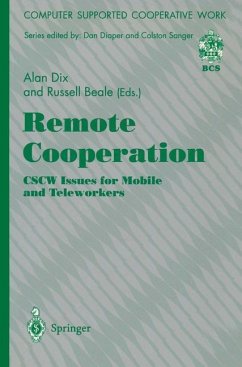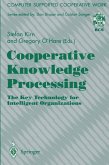- Broschiertes Buch
- Merkliste
- Auf die Merkliste
- Bewerten Bewerten
- Teilen
- Produkt teilen
- Produkterinnerung
- Produkterinnerung
Computer supported work is increasingly being done out of the traditional office environment, for example whilst travelling or at home and there is a growing need to support the cooperative aspects of such work. Remote Cooperation looks at ways of improving the available communications, through the use of packet radio and compression techniques, in order to reduce the imbalance between office-based and mobile workers. It also assesses how the effectiveness of the existing communications infrastructure can be improved, by providing cooperative applications which fit within its limitations.…mehr
Andere Kunden interessierten sich auch für
![Cooperative Knowledge Processing Cooperative Knowledge Processing]() Cooperative Knowledge Processing83,99 €
Cooperative Knowledge Processing83,99 €![CSCW Requirements and Evaluation CSCW Requirements and Evaluation]() CSCW Requirements and Evaluation83,99 €
CSCW Requirements and Evaluation83,99 €![Design Issues in CSCW Design Issues in CSCW]() Design Issues in CSCW42,99 €
Design Issues in CSCW42,99 €![Computer Supported Collaborative Writing Computer Supported Collaborative Writing]() Computer Supported Collaborative Writing42,99 €
Computer Supported Collaborative Writing42,99 €![Knowledge Management and Organizational Memories Knowledge Management and Organizational Memories]() Rose Dieng-Kuntz / Nada Matta (eds.)Knowledge Management and Organizational Memories83,99 €
Rose Dieng-Kuntz / Nada Matta (eds.)Knowledge Management and Organizational Memories83,99 €![Knowledge Management and Organizational Memories Knowledge Management and Organizational Memories]() Knowledge Management and Organizational Memories83,99 €
Knowledge Management and Organizational Memories83,99 €![Advances in Production Management Systems. The Path to Intelligent, Collaborative and Sustainable Manufacturing Advances in Production Management Systems. The Path to Intelligent, Collaborative and Sustainable Manufacturing]() Advances in Production Management Systems. The Path to Intelligent, Collaborative and Sustainable Manufacturing82,99 €
Advances in Production Management Systems. The Path to Intelligent, Collaborative and Sustainable Manufacturing82,99 €-
-
-
Computer supported work is increasingly being done out of the traditional office environment, for example whilst travelling or at home and there is a growing need to support the cooperative aspects of such work. Remote Cooperation looks at ways of improving the available communications, through the use of packet radio and compression techniques, in order to reduce the imbalance between office-based and mobile workers. It also assesses how the effectiveness of the existing communications infrastructure can be improved, by providing cooperative applications which fit within its limitations.
Broadly divided into five sections - social and economic context, application domains, software technology and infrastructure, communications technology and infrastructure, working and learning from home - this volume contains contributions from both the research community and industry.
Hinweis: Dieser Artikel kann nur an eine deutsche Lieferadresse ausgeliefert werden.
Broadly divided into five sections - social and economic context, application domains, software technology and infrastructure, communications technology and infrastructure, working and learning from home - this volume contains contributions from both the research community and industry.
Hinweis: Dieser Artikel kann nur an eine deutsche Lieferadresse ausgeliefert werden.
Produktdetails
- Produktdetails
- Computer Supported Cooperative Work
- Verlag: Springer, Berlin
- 1st Edition.
- Seitenzahl: 256
- Erscheinungstermin: 18. Oktober 1996
- Englisch
- Abmessung: 235mm x 155mm x 15mm
- Gewicht: 400g
- ISBN-13: 9783540760351
- ISBN-10: 3540760350
- Artikelnr.: 24957209
- Herstellerkennzeichnung Die Herstellerinformationen sind derzeit nicht verfügbar.
- Computer Supported Cooperative Work
- Verlag: Springer, Berlin
- 1st Edition.
- Seitenzahl: 256
- Erscheinungstermin: 18. Oktober 1996
- Englisch
- Abmessung: 235mm x 155mm x 15mm
- Gewicht: 400g
- ISBN-13: 9783540760351
- ISBN-10: 3540760350
- Artikelnr.: 24957209
- Herstellerkennzeichnung Die Herstellerinformationen sind derzeit nicht verfügbar.
So Near Yet So Far.- The Structure of this Book.- Framing the Problem.- Future Directions and Further Information.- 1 Working in the Virtual Office.- 1.1 Introduction.- 1.2 Why Are People Working in Virtual Offices?.- 1.3 Technology for the Virtual Office.- 1.4 Advantages of Working in a Virtual Office.- 1.5 Disadvantages of Working in a Virtual Office.- 1.6 Addressing the Disadvantages of the Virtual Office.- 2 CSCW for the Mobile Teleworker.- 2.1 Introduction.- 2.2 How Telework Concepts Affect Field Based Mobile Workers.- 2.3 How Telework Concepts Affect Intrinsically Mobile Workers.- 2.4 The Basic Technology for Mobile Telework.- 2.5 The Role of CSCW.- 2.6 The Basic Technology of CSCW for Mobile Workers.- 2.7 The Interaction Between CSCW and Telework.- 2.8 Teamworking Across Enterprise Boundaries.- 3 The Electronic Hard Hat: CSCW on the Construction Site.- 3.1 Introduction.- 3.2 Review of Past Work.- 3.3 Available Technology.- 3.4 CSCW on the Construction Site: a Possible Scenario.- 3.5 The Electronic Hard Hat.- 3.6 Future Scenarios.- 3.7 Conclusion: A Plea to Communications Companies.- 4 Support for Community Care.- 4.1 Introduction.- 4.2 Community Health Services and Community Care Workers.- 4.3 Community Care Systems.- 4.4 The Field Trial of System B.- 4.5 Some Results of the Evaluation Exercise.- 4.6 Comparison with System A.- 4.7 Conclusion.- 5 The' salesman's Promise': CSCW in Sales.- 5.1 Introduction.- 5.2 The Cell Based Factory.- 5.3 Sales Scenarios.- 5.4 Product Advisor.- 5.5 Conclusions.- 6 Observations on Practically Perfect CSCW.- 6.1 Introduction.- 6.2 General Requirements.- 6.3 Toward Observational Properties.- 6.4 Using the Model.- 6.5 Toward Practically Perfect CSCW.- 6.6 Conclusions.- Acknowledgements.- 7 Personal Information Management in theContext of Collaborative Work.- 7.1 Introduction.- 7.2 Personal Information Management and the Representational Focus.- 7.3 Time Management: A Case for CSCW?.- 7.4 Personal Information Management and CSCW.- 8 Activity Coordination in Decentralized Working Environments.- 8.1 Introduction.- 8.2 Some Aspects of Activity Coordination.- 8.3 The Task Manager: An Example for Activity Coordination.- 8.4 Consistency in an Asynchronous Environment.- 8.5 Conflict Handling.- 8.6 Mobility and Activity Coordination.- 8.7 Summary.- 8.8 Outlook.- 9 Information Requirements of Distributed Workers.- 9.1 Introduction.- 9.2 Background - The Workers and the Technology.- 9.3 Principal Topics.- 9.4 Retrieval and Caching.- 9.5 Synchronization.- 9.6 Other Areas and Future Work.- 9.7 Summary.- 10 Mobile Open Systems Technology for the Utilities Industries.- 10.1 Introduction.- 10.2 Requirements of Mobile Utilities Workers.- 10.3 Integration Technologies.- 10.4 Mobile Computing Technologies.- 10.5 The Impact of Mobility on Distributed Systems Platforms.- 10.6 The MOST Approach.- 10.7 Concluding Remarks.- 11 The Distributed Home Environment and the New Oikos.- 11.1 Introduction.- 11.2 The Oikos Concept.- 11.3 The Distributed Home and Telework.- 11.4 The Homelink Project.- 11.5 Future Directions.- 11.6 Summary.- 12 Teaching, Learning and Collaborating at a Virtual Summer School.- 12.1 Introduction.- 12.2 Design Issues.- 12.3 Teaching and Learning at a VSS.- 12.4 Evaluation and Discussion.- 12.5 Discussion and Conclusions.- Appendix: A Detailed Profile of the VSS Students.- References.- Name Index.
So Near Yet So Far.- The Structure of this Book.- Framing the Problem.- Future Directions and Further Information.- 1 Working in the Virtual Office.- 1.1 Introduction.- 1.2 Why Are People Working in Virtual Offices?.- 1.3 Technology for the Virtual Office.- 1.4 Advantages of Working in a Virtual Office.- 1.5 Disadvantages of Working in a Virtual Office.- 1.6 Addressing the Disadvantages of the Virtual Office.- 2 CSCW for the Mobile Teleworker.- 2.1 Introduction.- 2.2 How Telework Concepts Affect Field Based Mobile Workers.- 2.3 How Telework Concepts Affect Intrinsically Mobile Workers.- 2.4 The Basic Technology for Mobile Telework.- 2.5 The Role of CSCW.- 2.6 The Basic Technology of CSCW for Mobile Workers.- 2.7 The Interaction Between CSCW and Telework.- 2.8 Teamworking Across Enterprise Boundaries.- 3 The Electronic Hard Hat: CSCW on the Construction Site.- 3.1 Introduction.- 3.2 Review of Past Work.- 3.3 Available Technology.- 3.4 CSCW on the Construction Site: a Possible Scenario.- 3.5 The Electronic Hard Hat.- 3.6 Future Scenarios.- 3.7 Conclusion: A Plea to Communications Companies.- 4 Support for Community Care.- 4.1 Introduction.- 4.2 Community Health Services and Community Care Workers.- 4.3 Community Care Systems.- 4.4 The Field Trial of System B.- 4.5 Some Results of the Evaluation Exercise.- 4.6 Comparison with System A.- 4.7 Conclusion.- 5 The' salesman's Promise': CSCW in Sales.- 5.1 Introduction.- 5.2 The Cell Based Factory.- 5.3 Sales Scenarios.- 5.4 Product Advisor.- 5.5 Conclusions.- 6 Observations on Practically Perfect CSCW.- 6.1 Introduction.- 6.2 General Requirements.- 6.3 Toward Observational Properties.- 6.4 Using the Model.- 6.5 Toward Practically Perfect CSCW.- 6.6 Conclusions.- Acknowledgements.- 7 Personal Information Management in theContext of Collaborative Work.- 7.1 Introduction.- 7.2 Personal Information Management and the Representational Focus.- 7.3 Time Management: A Case for CSCW?.- 7.4 Personal Information Management and CSCW.- 8 Activity Coordination in Decentralized Working Environments.- 8.1 Introduction.- 8.2 Some Aspects of Activity Coordination.- 8.3 The Task Manager: An Example for Activity Coordination.- 8.4 Consistency in an Asynchronous Environment.- 8.5 Conflict Handling.- 8.6 Mobility and Activity Coordination.- 8.7 Summary.- 8.8 Outlook.- 9 Information Requirements of Distributed Workers.- 9.1 Introduction.- 9.2 Background - The Workers and the Technology.- 9.3 Principal Topics.- 9.4 Retrieval and Caching.- 9.5 Synchronization.- 9.6 Other Areas and Future Work.- 9.7 Summary.- 10 Mobile Open Systems Technology for the Utilities Industries.- 10.1 Introduction.- 10.2 Requirements of Mobile Utilities Workers.- 10.3 Integration Technologies.- 10.4 Mobile Computing Technologies.- 10.5 The Impact of Mobility on Distributed Systems Platforms.- 10.6 The MOST Approach.- 10.7 Concluding Remarks.- 11 The Distributed Home Environment and the New Oikos.- 11.1 Introduction.- 11.2 The Oikos Concept.- 11.3 The Distributed Home and Telework.- 11.4 The Homelink Project.- 11.5 Future Directions.- 11.6 Summary.- 12 Teaching, Learning and Collaborating at a Virtual Summer School.- 12.1 Introduction.- 12.2 Design Issues.- 12.3 Teaching and Learning at a VSS.- 12.4 Evaluation and Discussion.- 12.5 Discussion and Conclusions.- Appendix: A Detailed Profile of the VSS Students.- References.- Name Index.








